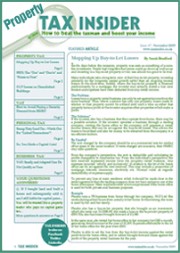Before you go, sign up to our free tax saving email course. Get 7 top property tax saving strategies in your email inbox that will help you save thousands in tax. Unsubscribe any time.
 In April 2009, the Chancellor announced that with effect from April 2010, the special tax breaks enjoyed by landlords of Furnished Holiday Accommodation would be withdrawn. We have been promised more detail in the Pre Budget Report on 9 December, but at the time of writing all we know is that the current tax year (2009/10) is the last one for which the old tax breaks will apply. In April 2009, the Chancellor announced that with effect from April 2010, the special tax breaks enjoyed by landlords of Furnished Holiday Accommodation would be withdrawn. We have been promised more detail in the Pre Budget Report on 9 December, but at the time of writing all we know is that the current tax year (2009/10) is the last one for which the old tax breaks will apply.
Furnished Holiday Accommodation is, broadly, furnished accommodation let on a short term basis (less than 31 days at a time) for at least ten weeks in the tax year, and available for such letting for at least twenty weeks. FHA landlords can claim “capital allowances” on expenditure on “plant and machinery” such as furniture, fridges, cookers, linen, knives and forks and so on. Given that there is a 100% “annual investment allowance” for the first £50,000 of such expenditure in the tax year, the majority of such landlords have effectively been able to claim the full cost of such capital expenditure in the year it is incurred. Given that the allowance includes “integral” items such as heating and plumbing systems, even quite major refurbishment could largely be claimed in full in the year. From April 2010, this will cease and FHA landlords will be on the same footing as others letting “residential accommodation”. Capital allowances cannot be claimed for expenditure on plant and machinery for use in residential accommodation. Instead, the landlord has a choice between two alternatives: Wear and Tear One point to note is that if you choose this allowance, you must apply it to all the furnished accommodation you let out – you cannot pick and choose between properties. Renewals The problem arises if you have previously been claiming capital allowances on such items. In the case of larger plant and machinery such as fridges and cookers, you cannot claim the cost of “renewing” an item of plant on which you have already claimed capital allowances. Effectively, you have to do the first renewal with no allowance for the cost, but when it comes time to replace that item, you can claim the renewals allowance. In the case of smaller items (“implements, articles and utensils”) the allowance for renewals is enshrined in statute and can be claimed even if the renewal is of a “utensil” on which capital allowances have been claimed. Watch out for this one – some tax inspectors think that you cannot switch from capital allowances to renewals without missing out the first renewal, as described above for larger items of plant and machinery. If they raise the issue, refer them to paragraph BIM46950 of their Business Income Manual. Repairs This article is from Tax Insider, a leading monthly UK tax magazine. Slash your taxes today and get the first issue of Tax Insider for free. |


 Tax Articles
Tax Articles